|
Spotsylvania Campaign
Civil War Virginia History
Spotsylvania Court House Campaign History
GENERAL HANCOCK's surprise and capture of the larger portion of Edward Johnson's division and the capture
of the salient "at Spotsylvania Court House on the 12th of May 1864, accomplished with the Second Corps," have been regarded
as one of the most brilliant feats of that brilliant soldier's career; but without the substantial assistance of general Wright,
grand old John Sedgwick's worthy successor, and the Sixth Corps, a defeat as bitter as his victory was sweet would have been
recorded against the hero of that day.
| Battle of Spotsylvania Court House |
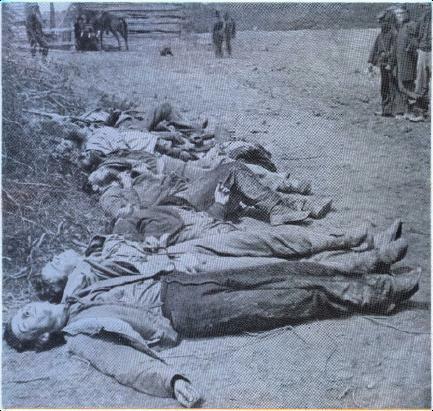
|
| Confederate Dead at Spotsylvania Battlefield |
The storm which had set
in early in the afternoon of the 11th of May continued with great severity, and but little rest was obtained during the night.
Soon after dark, however, a remarkable change in the weather took place; with their tents stretched about their shoulders,
while some hastily pitched the canvas on the ground, [they] sought shelter beneath the rumpled and dripping folds. Others
rolled themselves up, and lay close to the simmering logs, eager to catch a few moments' sleep; many crouched about, without
any shelter whatever, presenting a pitiable sight.
Throughout the day some skirmishing
and sharpshooting had occurred, but this had been of a spasmodic character, and had elicited no concern.
About dusk the Sixth Corps moved to a position on the right and rear of the army. The stormy night was favorable to Hancock's
movement, and about 10 o'clock he put his troops in motion, marching to a point on the left of the Sixth Corps' former position
in the neighborhood of the Brown house, massing his troops in that vicinity.
General Grant's orders to Hancock were to assault at daylight on the 12th in cooperation with Burnside on his left, while
Wright and Warren were held in readiness to assault on his right. The Confederate army
was composed of three corps-Longstreet (now R. H. Anderson) on their left, Ewell in the center, and A. P. Hill (now under
early) on the right. The point to be assaulted was a salient of field-works on the Confederate center, afterward called the
"Bloody Angle." It was held by General Edward Johnson's division. Here the Confederate line broke
off at an angle of ninety degrees, the right parallel, about the length of a small brigade, being occupied by General George
H. Steuart's regiments. This point was a part or continuation of the line of works charged and carried by General Upton on
May 10th, and was considered to be the key to Lee's position.
(Right) Confederate Dead after
the Battle of Spotsylvania Court House. The American Civil War through pictures had brought the carnage and killing fields
of the nation into the front door and onto the lap of every man, woman, and child. For many, it was surreal, it was unimaginable,
and they had a very difficult time with the massive losses of just a single battle. The Battle of Spotsylvania Court House,
for instance, had produced more casualties than all of the nation's previous wars combined. The innocence that many civilians
enjoyed by being far removed while enjoying routines of normalcy during the conflict -- that would claim
more than 620,000 American lives -- had been altered by a single snapshot of the photographer. And Lincoln,
facing the first presidential election during a time of war, would need to pull a political miracle if he was going to be
reelected during the greatest crisis in the history of the United States -- and "Honest Abe" would do just that in
1864. Courtesy National Archives.
Just as the day was breaking, Barlow's and Birney's divisions of Hancock's corps pressed forward upon the unsuspecting
foe, and leaping the breastworks after a hand-to-hand conflict with the bewildered enemy, in which guns were used as clubs,
possessed themselves of the intrenchments. Over three thousand prisoners were taken, including General Johnson and General
Steuart. Twenty Confederate cannon became the permanent trophies of the day, twelve of them belonging to Page and eight to
Cutshaw.
Upon reaching the second line of Lee's works held by Wilcox's division,
who by this time had become apprised of the disaster to their comrades, Hancock met with stern resistance, as Lee in the meantime
had been hurrying troops to Ewell from Hill on the right and Anderson on the left, and these were sprung upon our victorious
lines with such an impetus as to drive them hastily back toward the left of the salient.
As soon as the news of Hancock's good and ill success reached army headquarters, the Sixth Corps - Upton's brigade being in
advance - was ordered to move with all possible haste to his support. At a brisk pace we crossed a line of intrenchments a
short distance in our front, and, passing through a strip of timber, at once began to realize our nearness to the foe. It
was now about 6 o'clock, and the enemy, reenforced, were making desperate efforts to regain what they had lost.
Battle of Spotsylvania Court House Campaign
| Battle of Spotsylvania Court House Campaign Map |
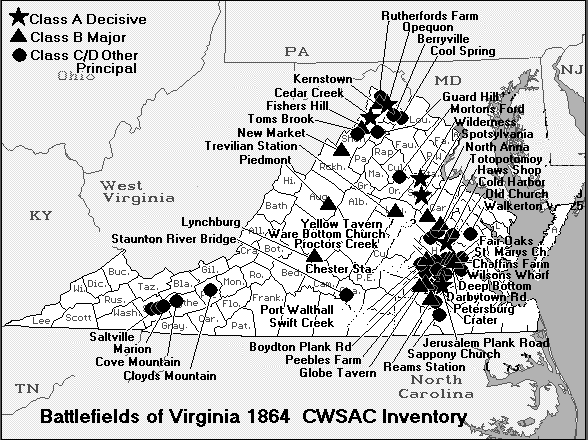
|
| Virginia Civil War Map of Battlefields |
The Battle of Spotsylvania, fought May 8-21, 1864, included some of the most desperate hand-to-hand fighting
of the Civil War
Our forces were hastily
retiring at this point before the concentrated attack of the enemy, and these with our wounded lined the road. We pressed
forward and soon cleared the woods and reached an insidious fen, covered with dense marsh grass, where we lay down for a few
moments awaiting orders. I cannot imagine how any of us survived the sharp fire that swept over us at this point - a fire
so keen that it split the blades of grass all about us, the minies moaning in a furious concert as they picked out victims
by the score.
The rain was still falling in torrents and held the country about
in obscurity. The command was soon given to my regiment, the 95th Pennsylvania Volunteers, Captain Macfarlain commanding,
it being the advance of Upton's brigade, to "rise up," whereupon with hurrahs we went forward, cheered on by Colonel Upton,
who had led us safe through the Wilderness. It was not long before we reached an angle of works constructed with great skill.
Immediately in our front an abatis had been arranged consisting of limbs and branches interwoven into one another, forming
footlocks of the most dangerous character. But there the works were, and over some of us went, many never to return. At this
moment Lee's strong line of battle, hastily selected for the work of retrieving ill fortune, appeared through the rain, mist,
and smoke. We received their bolts, losing nearly one hundred of our gallant 95th. Colonel Upton saw at once that this point
must be held at all hazards, for if Lee should recover the angle, he would push back our lines right and left, and the fruits
of the morning's victory would be lost. The order was at once given us to lie down and commence firing; the left of our regiment
rested against the works, while the right, slightly refused, rested upon an elevation in front. And now began a desperate
and pertinacious struggle.
Under cover of the smoke-laden rain the enemy was
pushing large bodies of troops forward, determined at all hazards to regain the lost ground. Could we hold on until the remainder
of our brigade should come to our assistance? Regardless of the heavy volleys of the enemy that were thinning our ranks, we
stuck to the position and returned the fire until the 5th Maine and the 121st New York of our brigade came to our support,
while the 96th Pennsylvania went in on our right; thus reenforced, we redoubled our exertions. The smoke, which was dense
at first, was intensified by each discharge of artillery to such an extent that the accuracy of our aim became very uncertain,
but nevertheless we kept up the fire in the supposed direction of the enemy. Meanwhile they were crawling forward under cover
of the smoke, until, reaching a certain point, and raising their usual yell, they charged gallantly up to the very muzzles
of our pieces and reoccupied the Angle.
| Battle of Spotsylvania Court House |
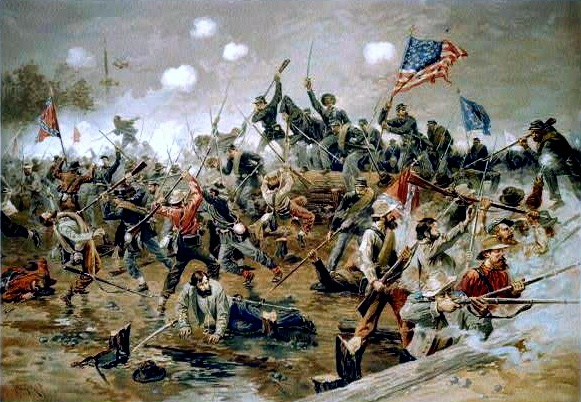
|
| Painting by Thulstrup |
Upon reaching the breastwork, the Confederates for a few moments had the advantage of us, and made good
use of their rifles. Our men went down by the score; all the artillery horses were down; the gallant Upton was the only mounted
officer in sight. Hat in hand, he bravely cheered his men, and begged them to "hold this point." All of his staff had been
either killed, wounded, or dismounted.
At this moment, and while the open ground
in rear of the Confederate works was choked with troops, a section of Battery C, 5th United States Artillery, under Lieutenant
Richard Metcalf, was brought into action and increased the carnage by opening at short range with double charges of canister.
This staggered the apparently exultant enemy. In the maze of the moment these guns were run up by hand close to the famous
Angle, and fired again and again, and they were only abandoned when all the drivers and cannoneers had fallen. The battle
was now at white heat.
The rain continued to fall, and clouds of smoke hung
over the scene. Like leeches we stuck to the work, determined by our fire to keep the enemy from rising up. Captain John D.
Fish, of Upton's staff, who had until this time performed valuable service in conveying ammunition to the gunners, fell, pierced
by a bullet. This brave officer seemed to court death as he rode back and forth between the caissons and cannoneers with stands
of canister under his "gum" coat. "Give it to them, boys! I'll bring you the canister," said he; and as he turned to cheer
the gunners, he fell from his horse, mortally wounded. In a few moments the two brass pieces of the 5th Artillery, cut and
hacked by the bullets of both antagonists, lay unworked with their muzzles projecting over the enemy's works, and their wheels
half sunk in the mud. Between the lines and near at hand lay the horses of these guns, completely riddled. The dead and wounded
were torn to pieces by the canister as it swept the ground where they had fallen.
The mud was half-way to our knees, and by our constant movement
the fallen were almost buried at our feet. We now backed off from the breastwork a few yards, abandoning for a while the two
12-pounders, but still keeping up a fusillade. We soon closed up our shattered ranks and the brigade settled down again to
its task. Our fire was now directed at the top of the breastworks, and woe be to the head or hand that appeared above it.
In the meantime the New Jersey brigade, Colonel W. H. Penrose, went into action on our right, and the Third Brigade, General
Eustis's, was hard at work. The Vermont brigade, under Colonel Lewis A. Grant, which had been sent to Barlow's assistance,
was now at the Angle, and General Wheaton's brigade was deep in the struggle. The Second and Third Divisions of the Sixth
Corps were also ready to take part. It will thus be seen that we had no lack of men for the defense or capture of this position,
whichever it may be termed.
The great difficulty was in the narrow limits of
the Angle, around which we were fighting, which precluded the possibility of getting more than a limited number into action
at once. At one time our ranks were crowded in some parts four deep by reenforcements. Major Henry P. Truefitt, commanding
the 119th Pennsylvania, was killed, and Captain Charles P. Warner, who succeeded him, was shot dead. Later in the day Major
William Ellis, of the 49th New York, who had excited our admiration, was shot through the arm and body with a ramrod during
one of the several attempts to get the men to cross the works and drive off the enemy. Our losses were frightful. What remained
of many different regiments that had come to our support had concentrated at this point and planted their tattered colors
upon a slight rise of ground close to the Angle, where they staid during the latter part of the day.
| Spotsylvania Campaign Virginia |
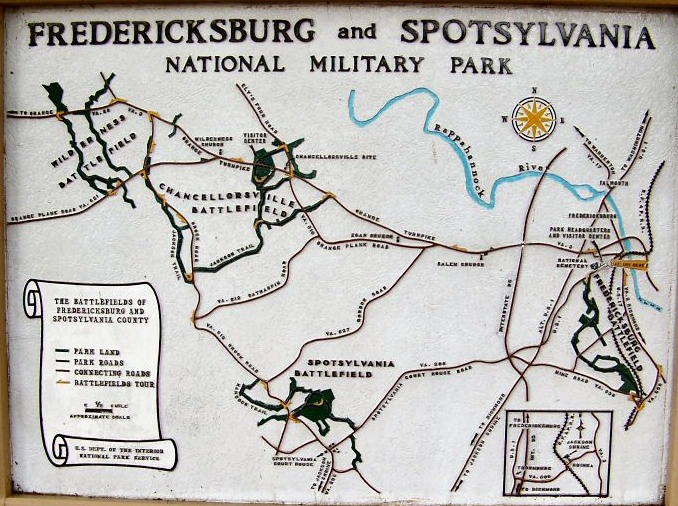
|
| Fredericksburg and Spotsylvania National Military Park |
To keep up the supply of ammunition pack mules were brought into
use, each animal carrying three thousand rounds. The boxes were dropped close behind the troops engaged, where they were quickly
opened by the officers or file-closers, who served the ammunition to the men. The writer fired four hundred rounds of ammunition,
and many others as many or more. In this manner a continuous and rapid fire was maintained, to which for a while the enemy
replied with vigor.
Finding that we were not to be driven back, the Confederates
began to use more discretion, exposing themselves but little, using the loop-holes in their works to fire through, and at
times placing the muzzles of their rifles on the top logs, seizing the trigger and small of the stock, and elevating the breech
with one hand sufficiently to reach us.
During the day a section of Cowan's
battery took position behind us, sending shell after shell close over our heads, to explode inside the Confederate works.
In like manner Coehorn mortars eight hundred yards in our rear sent their shells with admirable precision gracefully curving
over us. Sometimes the enemy's fire would slacken, and the moments would become so monotonous that something had to be done
to stir them up. Then some resolute fellow would seize a fence-rail or piece of abatis, and, creeping close to the breastworks,
thrust it over among the enemy, and then drop on the ground to avoid the volley that was sure to follow.
A daring lieutenant in one of our left companies leaped upon the breastworks, took a rifle that was handed to him, and discharged
it among the foe. In like manner he discharged another, and was in the act of firing a third shot when his cap flew up in
the air, and his body pitched headlong among the enemy.
On several occasions squads of disheartened Confederates raised pieces of shelter-tents above the works
as a flag of truce; upon our slacking fire and calling to them to come in, they would immediately jump the breastworks and
surrender.
One party of twenty or thirty thus signified their willingness to
submit; but owing to the fact that their comrades occasionally took advantage of the cessation to get a volley into us, it
was some time before we concluded to give them a chance. With leveled pieces we called to them to come in.
Springing upon the breastworks in a body, they stood for an instant panic-stricken at the terrible array before them; that
momentary y delay was the signal for their destruction. While we, with our fingers pressing the trigger, shouted to them to
jump, their troops, massed in the rear, poured a volley into them, killing or wounding all but a few, who dropped with the
rest and crawled in under our pieces, while we instantly began firing.
The battle,
which during the morning raged with more or less violence on the right and left of this position, gradually slackened, and
attention was concentrated upon the Angle. So continuous and heavy was our fire that the head logs of the breastworks were
cut and torn until they resembled hickory brooms. Several large oak-trees, which grew just in the rear of the works, were
completely gnawed off by our converging fire, and about 3 o'clock in the day fell among the enemy with a loud crash.
Toward dusk preparations were made to relieve us. By this time we were nearly exhausted, and had fired three to four hundred
rounds per man. Our lips were incrusted with powder from "biting cartridge." Our shoulders and hands were coated with
mud that had adhered to the butts of our rifles.
| Battle of Spotsylvania Court House |
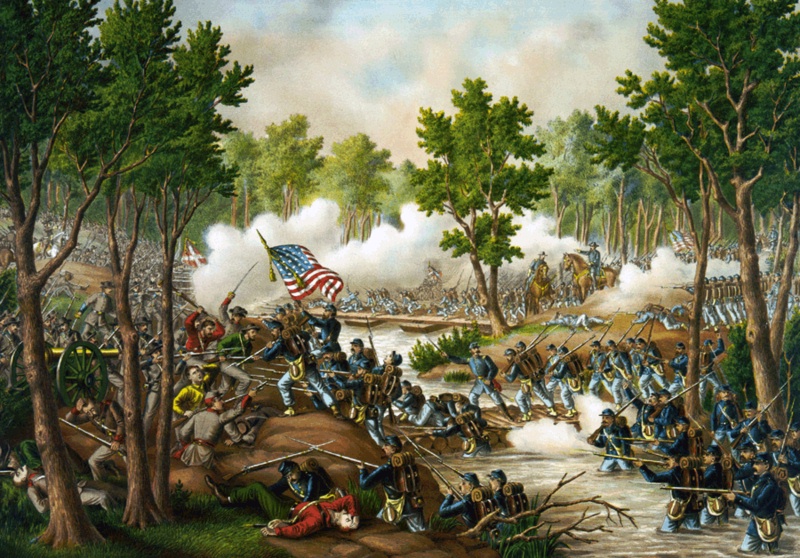
|
| Battle of Spottsylvania by Kurz and Allison |
The troops of the Second Corps, who were to relieve us, now moved
up, took our position, and opened fire as we fell back a short distance to rearrange our shattered ranks and get something
to eat, which we were sadly in need of. When darkness came on we dropped from exhaustion.
About midnight, after twenty hours of constant fighting, Lee withdrew from the contest at this point, leaving the Angle in
our possession. Thus closed the battle of the 12th of May. On the 13th, early in the day, volunteers were called for
to bury the dead. The writer volunteered to assist, and with the detail moved to the works near the Angle, in front of which
we buried a number of bodies near where they fell. We were exposed to the fire of sharp shooters, and it was still raining.
We cut the name, company, and regiment of each of the dead on the lids of ammunition-boxes which we picked up near by.
The inscriptions were but feebly executed, for they were done with a pocket-knife. This worked, we went close up where we
had fought on Thursday and viewed the "Bloody Angle."
A momentary gleam of sunshine
through the· gloom of the sky seemed to add a new horror to the scene. Hundreds of Confederates, dead or dying, lay piled
over one another in those pits.
The fallen lay three or four feet deep in some
places, and, with but few exceptions, they were shot in and about the head. Arms, accouterments, ammunition, cannon, shot
and shell, and broken foliage were strewn about. With much labor a detail of Union soldiers buried the dead by simply turning
the captured breastworks upon them.
Thus had these unfortunate victims unwittingly
dug their own graves. The trenches were nearly full of muddy water. It was the most horrible sight I had ever witnessed.
The enemy's defenses at this point were elaborately constructed of heavy timber, banked with earth to the height of about
four feet; above this: was placed what is known as a head log, raised just high enough to enable a musket to be inserted between
it and the lower work. Pointed pine and pin-oak formed an abatis, in front of which was a deep ditch. Shelves ran along the
inside ledges of these works (a series of square pits) and along their flank traverses which extended to the rear; upon these
shelves large quantities of "buck and ball" and "minie" cartridges were piled ready for use, and the guns of the dead and
wounded were still pointing through the apertures, just as the men had fallen from them.
(Related reading below.)
Sources: Battles and Leaders of the Civil War; Confederate Dead at Spotsylvania
Battlefield Picture Courtesy National Archives; Painting by Thulstrup; Battle of Spottsylvania by Kurz and Allison, Courtesy
Library of Congress; Fredericksburg and Spotsylvania National Military Park.
Recommended
Reading: To the North Anna River: Grant And Lee, May 13-25, 1864 (Jules and Frances Landry Award Series).
Description: With To the North Anna River, the third book
in his outstanding five-book series, Gordon C. Rhea continues his spectacular narrative of the initial campaign between Ulysses
S. Grant and Robert E. Lee in the spring of 1864. May 13 through 25, a phase oddly ignored by historians, was critical in
the clash between the Army of the Potomac and the Army of Northern Virginia. During those thirteen days—an interlude
bracketed by horrific battles that riveted the public’s attention—a game of guile and endurance between Grant
and Lee escalated to a suspenseful draw on Virginia’s North Anna River. Continued below...
From the bloodstained
fields of the Mule Shoe to the North Anna River, with Meadow Bridge, Myers Hill, Harris Farm, Jericho Mills, Ox Ford, and
Doswell Farm in between, grueling night marches, desperate attacks, and thundering cavalry charges became the norm for both
Grant’s and Lee’s men. But the real story of May 13–25 lay in the two generals’ efforts to outfox
each other, and Rhea charts their every step and misstep. Realizing that his bludgeoning tactics at the Bloody Angle were
ineffective, Grant resorted to a fast-paced assault on Lee’s vulnerable points. Lee, outnumbered two to one, abandoned
the offensive and concentrated on anticipating Grant’s maneuvers and shifting quickly enough to repel them. It was an
amazingly equal match of wits that produced a gripping, high-stakes bout of warfare—a test, ultimately, of improvisation
for Lee and of perseverance for Grant.
Advance to:
Recommended Reading: The Battles
For Spotsylvania Court House And The Road To Yellow
Tavern, May 7-12, 1864. Description: The
second volume in Gordon C. Rhea's peerless five-book series on the Civil War's 1864 Overland Campaign abounds with Rhea's
signature detail, innovative analysis, and riveting prose. Here Rhea examines the maneuvers and battles from May 7, 1864,
when Grant left the Wilderness, through May 12, when his attempt to break Lee's line by frontal assault reached a chilling
climax at what is now called the Bloody Angle. Drawing exhaustively upon previously untapped materials, Rhea challenges conventional
wisdom about this violent clash of titans to construct the ultimate account of Grant and Lee at Spotsylvania.
Continued below…
About
the Author: Gordon C. Rhea is also the author
of The Battle of the Wilderness, May 5–6, 1864; To the North Anna River: Grant and Lee, May 13–25, 1864, winner
of the Fletcher Pratt Literary Award; Cold Harbor: Grant and Lee, May 26–June 3, 1864, winner of the Austin Civil War
Round Table’s Laney Prize, and Carrying the Flag: The Story of Private Charles Whilden, the Confederacy’s Most
Unlikely Hero. He lives in St.
Croix, U.S. Virgin Islands, and in Mt. Pleasant, South Carolina, with his wife and two sons.
Recommended Reading: The Spotsylvania
Campaign: May 7-21, 1864 (Great Campaigns). Description: A very detailed
examination of the Spotsylvania Campaign. A dramatic study of the campaign and the clash of the titans - Robert E. Lee against
Ulysses S. Grant – and it is a book that you will refuse to put down. Continued below…
About
the Author: John Cannan has established
a reputation among Civil War writers in a remarkably short time. His distinctions include three books selected by the Military
Book Club. He is the author of The Atlanta Campaign, The Wilderness Campaign, and The Spotsylvania Campaign. Cannan is an
historic preservation attorney residing in Baltimore.
Recommended Reading: Trench Warfare under Grant and Lee: Field Fortifications in the Overland Campaign (Civil
War America) (Hardcover). Description: In the study of field fortifications in the Civil War that began with Field Armies
and Fortifications in the Civil War, Hess turns to the 1864 Overland campaign to cover battles from the Wilderness to Cold Harbor. Drawing on meticulous research in primary sources and careful examination of trench remnants
at the Wilderness, Spotsylvania, North Anna, Cold Harbor, and Bermuda Hundred, Hess describes Union
and Confederate earthworks and how Grant and Lee used them in this new era of field entrenchments.
Recommended Reading: The Spotsylvania
Campaign (Military Campaigns of the Civil War) (Hardcover). Description: The Spotsylvania Campaign marked a crucial period in the confrontation between Ulysses S. Grant and
Robert E. Lee in Virginia. Waged over a two-week period
in mid-May 1864, it included some of the most savage fighting of the Civil War and left indelible marks on all involved. Approaching
topics related to Spotsylvania from a variety of perspectives, the contributors to this volume
explore questions regarding high command, tactics and strategy, the impact of fighting on officers and soldiers in both armies,
and the ways in which some participants chose to remember and interpret the campaign. They offer insight into the decisions
and behavior of Lee and of Federal army leaders, the fullest descriptions to date of the horrific fighting at the "Bloody
Angle" on May 12, and a revealing look at how Grant used his memoirs to offset Lost Cause interpretations of his actions at
Spotsylvania and elsewhere in the Overland Campaign. Continued below...
Meet the Contributors:
—William
A. Blair, Grant's Second Civil War: The Battle for Historical Memory
—Peter S. Carmichael, We Respect a Good
Soldier, No Matter What Flag He Fought Under: The 15th New Jersey Remembers Spotsylvania
—Gary W. Gallagher, I Have
to Make the Best of What I Have: Robert E. Lee at Spotsylvania
—Robert E. L. Krick, Stuart's Last Ride: A Confederate
View of Sheridan's Raid
—Robert K. Krick, An Insurmountable Barrier between the Army and Ruin: The Confederate Experience
at Spotsylvania's Bloody Angle
—William D. Matter, The Federal High Command at Spotsylvania
—Carol Reardon,
A Hard Road to Travel: The Impact of Continuous Operations on the Army of the Potomac and the Army of Northern Virginia in
May 1864
—Gordon C. Rhea, The Testing of a Corp Commander: Gouverneur Kemble Warren at the Wilderness and Spotsylvania
Recommended Reading:
If It Takes All Summer: The Battle of Spotsylvania (Hardcover). Description: The termination
of the war and the fate of the Union hung in the balance in May of 1864 as Robert E. Lee's Army of Northern Virginia and Ulysses
S. Grant's Army of the Potomac clashed in the Virginia countryside—first in the battle of the Wilderness, where the
Federal army sustained greater losses than at Chancellorsville, and then further south in the vicinity of Spotsylvania Courthouse,
where Grant sought to cut Lee's troops off from the Confederate capital of Richmond. This is the first book-length examination
of the pivotal Spotsylvania campaign of 7-21 May. Drawing on extensive research in manuscript
collections across the country and an exhaustive reading of the available literature, William Matter sets the strategic stage
for the campaign before turning to a detailed description of tactical movements. He offers abundant fresh material on race
from the Wilderness to Spotsylvania, the role of Federal and Confederate cavalry, Emory Upton's brilliantly conceived Union
assault on 10 May, and the bitter clash on 19 May at the Harris farm. Throughout the book, Matter assesses each side's successes,
failures, and lost opportunities and sketches portraits of the principal commanders. Continued below...
The centerpiece
of the narrative is a meticulous and dramatic treatment of the horrific encounter in the salient that formed the Confederate
center on 12 May. There the campaign reached its crisis, as soldiers waged perhaps the longest and most desperate fight of
the entire war for possession of the Bloody Angle—a fight so savage that trees were literally shot to pieces by musket
fire. Matter's sure command of a mass of often-conflicting testimony enables him to present by far the clearest account to
date of this immensely complex phase of the battle. Rigorously researched, effectively presented, and well supported by maps,
this book is a model tactical study that accords long overdue attention to the Spotsylvania campaign. It will quickly take its place in the front rank of military studies
of the Civil War.
|

